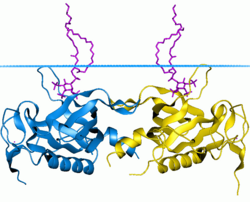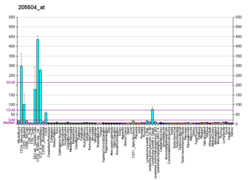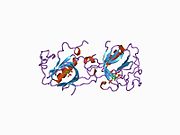Bruton's tyrosine kinase
Bruton's tyrosine kinase (abbreviated Btk or BTK) also known as tyrosine-protein kinase BTK is an enzyme that in humans is encoded by the BTK gene. BTK is a kinase that plays a crucial role in B-cell development.
Function
BTK plays a crucial role in B cell maturation as well as mast cell activation through the high-affinity IgE receptor.[5]
Btk contains a PH domain that binds phosphatidylinositol (3,4,5)-trisphosphate (PIP3). PIP3 binding induces Btk to phosphorylate phospholipase C, which in turn hydrolyzes PIP2, a phosphatidylinositol, into two second messengers, inositol triphosphate (IP3) and diacylglycerol (DAG), which then go on to modulate the activity of downstream proteins during B-cell signalling.[5]
Clinical significance
Mutations in the BTK gene are implicated in the primary immunodeficiency disease X-linked agammaglobulinemia (Bruton's agammaglobulinemia); sometimes abbreviated to XLA. Patients with XLA have normal pre-B cell populations in their bone marrow but these cells fail to mature and enter the circulation. The Btk gene is located on the X chromosome.[6] At least 400 mutations of the BTK gene have been identified.
BTK inhibitors
Approved drugs that inhibit BTK :
Various drugs that inhibit BTK are in clinical trials:[7]
- Phase 3:
- Acalabrutinib, for relapsed CLL, 95% overall remission reported.
- Phase 2:
- Phase 1:
- ONO-4059 for Non-Hodgkin's Lymphoma and/or CLL.[8] Renamed GS-4059 and now in trial NCT02457598.[9]
- spebrutinib (AVL-292, CC-292) [10]
- BGB-3111 for CLL.[9] It can be taken orally.[11]
Discovery
Bruton's tyrosine kinase was discovered in 1993 and is named for Ogden Bruton, who first described XLA in 1952.[6]
Interactions
Bruton's tyrosine kinase has been shown to interact with:
See also
- Ibrutinib (PCI-32765), a selective Bruton's tyrosine kinase inhibitor
References
- ^ a b c GRCh38: Ensembl release 89: ENSG00000010671 – Ensembl, May 2017
- ^ a b c GRCm38: Ensembl release 89: ENSMUSG00000031264 – Ensembl, May 2017
- ^ "Human PubMed Reference:". National Center for Biotechnology Information, U.S. National Library of Medicine.
- ^ "Mouse PubMed Reference:". National Center for Biotechnology Information, U.S. National Library of Medicine.
- ^ a b c Seda V, Mraz M (Mar 2015). "B-cell receptor signalling and its crosstalk with other pathways in normal and malignant cells". European Journal of Haematology. 94 (3): 193–205. doi:10.1111/ejh.12427. PMID 25080849.
- ^ a b X-Linked Agammaglobulinemia Patient and Family Handbook for The Primary Immune Diseases. Third Edition. 2001. Published by the Immune Deficiency Foundation.
- ^ Astra Signals A Late Run On BTK Inhibition. Dec 2015
- ^ Clinical trial number NCT01659255 for "ONO-4059 Phase I Dose-escalation Study to Investigate the Safety and Tolerability of ONO-4059 Given as Monotherapy in Patients With Relapsed/Refractory Non-Hodgkin's Lymphoma and/or Chronic Lymphocytic Leukaemi" at ClinicalTrials.gov
- ^ a b Novel BTK, PI3K Inhibitors on Horizon for Relapsed CLL. March 2016
- ^ Clinical trial number NCT01351935 for "Escalating Dose Study in Subjects With Relapsed or Refractory B Cell Non-Hodgkin Lymphoma, Chronic Lymphocytic Leukemia, and Waldenstrom's Macroglobulinemia" at ClinicalTrials.gov
- ^ BeiGene Announces Initiation of a Combination Trial of the BTK Inhibitor BGB-3111 with the PD-1 Antibody BGB-A317. June 2016
- ^ Nixon JC, Rajaiya JB, Ayers N, Evetts S, Webb CF (March 2004). "The transcription factor, Bright, is not expressed in all human B lymphocyte subpopulations". Cell. Immunol. 228 (1): 42–53. doi:10.1016/j.cellimm.2004.03.004. PMID 15203319.
- ^ a b Yasuda T, Tezuka T, Maeda A, Inazu T, Yamanashi Y, Gu H, Kurosaki T, Yamamoto T (July 2002). "Cbl-b positively regulates Btk-mediated activation of phospholipase C-gamma2 in B cells". J. Exp. Med. 196 (1): 51–63. doi:10.1084/jem.20020068. PMC 2194016. PMID 12093870.
- ^ Hashimoto S, Iwamatsu A, Ishiai M, Okawa K, Yamadori T, Matsushita M, Baba Y, Kishimoto T, Kurosaki T, Tsukada S (October 1999). "Identification of the SH2 domain binding protein of Bruton's tyrosine kinase as BLNK--functional significance of Btk-SH2 domain in B-cell antigen receptor-coupled calcium signaling". Blood. 94 (7): 2357–64. PMID 10498607.
- ^ Vargas L, Nore BF, Berglof A, Heinonen JE, Mattsson PT, Smith CI, Mohamed AJ (March 2002). "Functional interaction of caveolin-1 with Bruton's tyrosine kinase and Bmx". J. Biol. Chem. 277 (11): 9351–7. doi:10.1074/jbc.M108537200. PMID 11751885.
{{cite journal}}: CS1 maint: unflagged free DOI (link) - ^ Ma YC, Huang XY (October 1998). "Identification of the binding site for Gqalpha on its effector Bruton's tyrosine kinase". Proc. Natl. Acad. Sci. U.S.A. 95 (21): 12197–201. doi:10.1073/pnas.95.21.12197. PMC 22808. PMID 9770463.
- ^ Sacristán C, Tussié-Luna MI, Logan SM, Roy AL (February 2004). "Mechanism of Bruton's tyrosine kinase-mediated recruitment and regulation of TFII-I". J. Biol. Chem. 279 (8): 7147–58. doi:10.1074/jbc.M303724200. PMID 14623887.
{{cite journal}}: CS1 maint: unflagged free DOI (link) - ^ Novina CD, Kumar S, Bajpai U, Cheriyath V, Zhang K, Pillai S, Wortis HH, Roy AL (July 1999). "Regulation of nuclear localization and transcriptional activity of TFII-I by Bruton's tyrosine kinase". Mol. Cell. Biol. 19 (7): 5014–24. doi:10.1128/mcb.19.7.5014. PMC 84330. PMID 10373551.
- ^ Yang W, Desiderio S (January 1997). "BAP-135, a target for Bruton's tyrosine kinase in response to B cell receptor engagement". Proc. Natl. Acad. Sci. U.S.A. 94 (2): 604–9. doi:10.1073/pnas.94.2.604. PMC 19560. PMID 9012831.
- ^ Guo B, Kato RM, Garcia-Lloret M, Wahl MI, Rawlings DJ (August 2000). "Engagement of the human pre-B cell receptor generates a lipid raft-dependent calcium signaling complex". Immunity. 13 (2): 243–53. doi:10.1016/s1074-7613(00)00024-8. PMID 10981967.
- ^ Johannes FJ, Hausser A, Storz P, Truckenmüller L, Link G, Kawakami T, Pfizenmaier K (November 1999). "Bruton's tyrosine kinase (Btk) associates with protein kinase C mu". FEBS Lett. 461 (1–2): 68–72. doi:10.1016/S0014-5793(99)01424-6. PMID 10561498.
- ^ Matsushita M, Yamadori T, Kato S, Takemoto Y, Inazawa J, Baba Y, Hashimoto S, Sekine S, Arai S, Kunikata T, Kurimoto M, Kishimoto T, Tsukada S (April 1998). "Identification and characterization of a novel SH3-domain binding protein, Sab, which preferentially associates with Bruton's tyrosine kinase (BtK)". Biochem. Biophys. Res. Commun. 245 (2): 337–43. doi:10.1006/bbrc.1998.8420. PMID 9571151.
- ^ Yamadori T, Baba Y, Matsushita M, Hashimoto S, Kurosaki M, Kurosaki T, Kishimoto T, Tsukada S (May 1999). "Bruton's tyrosine kinase activity is negatively regulated by Sab, the Btk-SH3 domain-binding protein". Proc. Natl. Acad. Sci. U.S.A. 96 (11): 6341–6. doi:10.1073/pnas.96.11.6341. PMC 26883. PMID 10339589.
Further reading
- Ochs HD, Aruffo A (1993). "Advances in X-linked immunodeficiency diseases". Curr. Opin. Pediatr. 5 (6): 684–91. doi:10.1097/00008480-199312000-00008. PMID 7907259.
- Uckun FM (1998). "Bruton's tyrosine kinase (BTK) as a dual-function regulator of apoptosis". Biochem. Pharmacol. 56 (6): 683–91. doi:10.1016/S0006-2952(98)00122-1. PMID 9751072.
- Tsubata T, Wienands J (2001). "B cell signaling. Introduction". Int. Rev. Immunol. 20 (6): 675–8. doi:10.3109/08830180109045584. PMID 11913944.
- Etzioni A (2002). "Novel aspects of hypogammaglobulinemic states". Isr. Med. Assoc. J. 4 (4): 294–7. PMID 12001708.
- Niiro H, Clark EA (2003). "Branches of the B cell antigen receptor pathway are directed by protein conduits Bam32 and Carma1". Immunity. 19 (5): 637–40. doi:10.1016/S1074-7613(03)00303-0. PMID 14614850.
- Carpenter CL (2004). "Btk-dependent regulation of phosphoinositide synthesis". Biochem. Soc. Trans. 32 (Pt 2): 326–9. doi:10.1042/BST0320326. PMID 15046600.
- Hendriks RW, Kersseboom R (2006). "Involvement of SLP-65 and Btk in tumor suppression and malignant transformation of pre-B cells". Semin. Immunol. 18 (1): 67–76. doi:10.1016/j.smim.2005.10.002. PMID 16300960.
External links
- GeneReviews/NCBI/NIH/UW entry on X-Linked or Brunton's Agammaglobulinemia
- UMich Orientation of Proteins in Membranes protein/pdbid-1bwn
- Bruton's+tyrosine+kinase at the U.S. National Library of Medicine Medical Subject Headings (MeSH)














